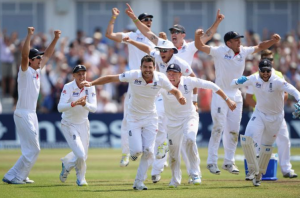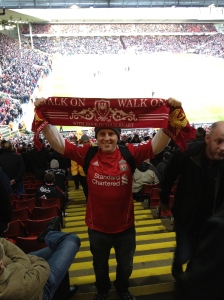By Justin Davies ( @DragonPunk12 )
Rain, rain go away come back again never!
So a draw that is something different. An Australian finally made a century and besides the small precipitation drops that ended day five it was a good test for the tourists despite losing the ability to regain the Ashes.
It was a new dawn for the Australian team after the massive defeat at Lords. Nathan Lyon, Mitchell Starc and David Warner came in after the wheel of selection misfortune landed on their names. The bowling contingent breathed a sigh of relief as 1) Australia won the toss and batted! 2) They weren’t going to be bowling with a total under 300.
Further proving this new dawn, Shane Watson showed that he was a jack of all trades, getting out caught instead of lbw. The Australians led by Captain Michael Clarke applied themselves for batting longer than an hour and it produced results with Clarke making the first century of an Australian in this series while Rogers and Smith made 84 and 89 respectively.
In making 527, Australia still managed to be spun out by Graeme Swann who picked up another five for including Usman Khawaja who was given out after review despite not touching the ball. The use of DRS is continuing to provide evidence to eradicate the technology. This Ashes series has been blighted heavily with umpiring and DRS mistakes taking the spotlight off the actual cricket being played.
For the first time in the series when it was needed, Australia put on some runs on the board forcing England to start their innings half an hour before close on day two. Peter Siddle threw a spanner in the works picking up Joe Root and later, nightwatchmen Tim Bresnan to leave them 2/49 with following on a distinct possibility.
Someone had to step up for the home side to make Australia sweat and up stepped the figure they needed, Kevin Pietersen. He is a batsman who can take the game away from a side in a session with a positive batting approach and he took to the Australian bowlers on his way to the fourth English century of the series and nudged them towards passing the follow on.
The problem as England passed the follow on, was the spinners. Australia hadn’t had large contributions from their slower bowlers in this series. If a result was to be forced in this test and keep the series alive, Nathan Lyon needed to step up much like Graeme Swann did in the first innings. He produced a tight line but it wasn’t penetrating as he picked up a single tail end wicket leaving the work to the pace bowlers to take the remaining nine leaving England trailing by 159 but looking likely for a draw.
Since they couldn’t lean on the follow on – Australia needed to plunder some quick runs to leave themselves enough time to bowl out England with the ominous presence of rain. Clarke knowing this sent David Warner up the order in a shuffled batting line-up including Shane Watson batting at four. Warner once again found his nemesis in Joe Root with a misguided hook but the following batsmen kept the scoring up work the lead past 300. There wasn’t going to be much more play after the umpire’s took off the players for bad light despite Clarke’s protests to throw more drama into a series starting to resemble the bold and beautiful more than cricket.
The rain that was predicted on day four held off but came in bucketloads on the final day when it wasn’t needed. The rain held off long enough for play to get underway allowing Ryan Harris to take the crucial wicket of Alastair Cook for a duck plus wasting a review. Harris added another along with Siddle to leave England 3/37 but down came the rain, washing Australia’s Ashes chances away with no play after lunch.
The home side had retained the Ashes for the fourth time since 2009, celebrating with the crowd who had braved the forecast for the job being done at home. Australia on the other hand have pride to play for in the final two tests before looking to win back the urn back on home soil.
pic: ecbtv







